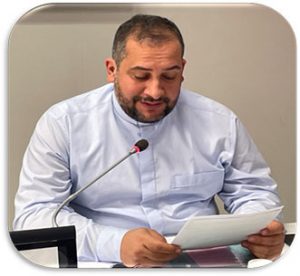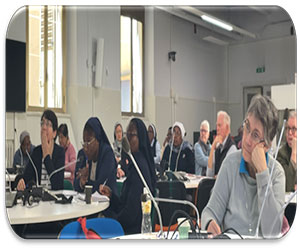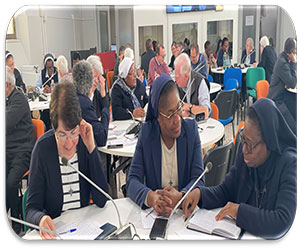
I am asked to share my reflection on hope from a Latin American perspective. I suppose this has to be done in the context of the seminar’s main theme, “Mission of Hope: Gifts from Each Continent Today.”
Situating my perspective
I come from Itabira, Minas Gerais, southeast of Brazil. A city that has existed since 1720. As the name indicates, Minas Gerais (general mines) attracted the Portuguese colonizers because of their gold and iron minerals. The State of Minas Gerais is known for its traditional Catholicism inherited from the Portuguese. There, you find century-old churches resulting from a historical period known as the Brazilian Baroque, which emerged in the 17th century. A great stress on popular devotion, art, sacraments, and an extremely hierarchical and triumphant Church marked Catholicism in Minas Gerais for many decades. The Church in Minas Gerais resembles many parts of Brazil, Latin America, and Caribbean countries. From this perspective, I can affirm that the Portuguese and the Spanish missionaries had similar approaches to “implementing” the Christian Catholic faith in the region.
Colonization and Evangelization in Latin America and the Caribbean
The colonizers came to explore our natural resources and brought along the Franciscans, the Dominicans, and the Jesuits to evangelize and educate the locals. Evangelization was overshadowed by the exploitation of natural resources, slavery, and the extinction of many indigenous peoples and their cultures. Not so long ago, our countries achieved independence and the abolition of slavery. To a certain extent, the autochthones achieved their autonomy and freedom. Remembering my history lessons, my teachers differed on the Catholic Church’s attitude towards the colonizers and the autochthones. While some said that the Catholic Church was prophetic and favored the locals, others inferred that the Catholic Church was complicit with the colonizers and contributed to the manipulation and exploitation of the local people. This is a subject that deserves further debate and research.
Many decades have passed since Latin American and Caribbean countries conquered independence, but they still haven’t fully overcome the evils of social inequality, poverty, violence, and injustice. The extinction of indigenous peoples in many parts of the continent is still going on. The devastation of our forests and mountains continues. The international market controls our economy and enslaves our people. The sufferings of the Latin American and Caribbean people remain in a different time and context. Today, there is no more talk about maritime expansion led by Portugal and Spain, but we find ourselves at the mercy of the international financial market and the International Monetary Fund. Unemployment, homelessness, joblessness, and extreme social inequality show that our continent still has a lot to improve in terms of human and social development.
Vatican II and the Latin America and Caribbean Church
At the level of the Roman Catholic Church, a significant paradigm shift occurred in Latin America and the Caribbean after Vatican II. It is common knowledge that this Council was an event of profound renewal (aggiornamento) for the Universal Church, thus motivating all the episcopal conferences in the world to look for appropriate ways to respond seriously to this spirit of renewal. However, one of the fundamental intuitions brought about by the Council was the desire to build a “poor Church” at the service of the “poor.” Pope John XXIII expressed this intuition when he convened the Council. This was later taken up and developed during the Second General Conference of the Latin American Bishops in Medellín, Colombia, in 1968 and in the conferences that followed it.
For Saint John XXIII, “the Church presents herself as she is, and wants to be, the Church of all, particularly the Church of the poor.” The expression “particularly the Church of the poor” is undoubtedly one of the Pope’s most important statements that paved the way for the emergence of the Liberation Theology developed in Latin America, whose central theme was, according to Gustavo Gutierrez, the “irruption of the poor.” The poor in the world have become the Church’s most vehement concern.
The pontificate of Saint John XXIII showed considerable interest in many countries’ ecclesial and social realities. Bishops from poor countries began to be heard from the moment the Council saw the need to seek prophetic dialogue and solidarity, recognizing that the Church could not prevent itself from listening to the cries of the poor. This perception would contribute profoundly to the much-desired aggiornamento that went beyond the walls of the Vatican and reached a global scope, especially in the Church in the Third World.
In terms of Hope, the Church in Latin America and the Caribbean represents an audacious example for the Universal Church regarding the reception of the Second Vatican Council and the role of the poor in a Church that wants to renew itself. CELAM ‘s documents represent an effort to give the Council a Latin American and Caribbean face. It is a question of creative fidelity to the Council, putting its call for the Church’s pastoral renewal and dialogue with the world into practice.
The Second Vatican Council changed the course of the Church, placing it in a perennial process of ecclesial, pastoral, and theological renewal. With the Council, a legitimate awakening to the lethargy that the official Church had suffered before it took place, especially in the face of the suffering of the impoverished. The Council was received as a paradigmatic, innovative, and prophetic event in Latin America and the Caribbean. Bishops, theologians, and lay people began to think about the changes proposed by the Council from the perspective of their realities.
In the aftermath of the Council, the Church in Latin America and the Caribbean Church found itself refreshed, dynamic, and prophetic. The Church’s missionary activity in this period required an ecclesial experience incarnated in the reality of people. The social struggles, the culture, and the values of the ordinary people could not be ignored. It is important to mention that at this time (60s, 70s, 80s, and 90s), many countries were under dictatorship, and the Church stood as the voice of the voiceless.
The first missionaries of the Congregation of the Immaculate Heart of Mary (Belgians and Dutch) arrived in Brazil in 1963. Their main purpose in going to the country was to help the local churches implement the pastoral renewal of the Church proposed by the Council. They were profoundly impressed and touched by the prophetic presence of the Church in Brazil. They discovered a new way of doing missions very different from what they had learned in Europe. They began to deepen an ecclesiology that considers the cry of the poor and a renewed approach to the Church’s mission that focuses on evangelization as journeying with the people.
A “contextual hope”
The post-Vatican II period was a fructiferous period for theological reflection in the region. Several theologians emerged, one of them being the Peruvian Gustavo Gutiérrez. He is considered to be one of the fathers of Liberation Theology. Throughout his theology, he shows a great predilection for historical praxis. His Christology was developed based on the historical Jesus. The same happens with his ecclesiology since the Church is seen through its insertion in history. However, his Christology and ecclesiology are not limited to historical factors. His theology is both historical and metahistorical. Thus, he affirms:
The mystery of God, however, does not end with history: ‘For now, we see in a mirror dimly, but then face to face; now I know in part, but then I will know fully just as I also have been fully known’ (1 Cor 13:12), the apostle Paul tells us. Looking in a mirror, and within this limitation, are these pages. They are animated by the hope that a time will come when the shadows and reflections will disappear and then we will see face to face, knowing as we are known. Charity, the virtue (meaning strength) that will prevail, leads us from now on to a joyful and grateful attitude to the gift of God’s love.
Hope is meta-historical. If memory serves me right, eschatology affirms that the final state or ultimate end of all things will not be fulfilled within history. All reality is moving towards an ultimate end beyond history, which is metahistorical but does not exclude history. The Kingdom of God, inaugurated by the ministry of Jesus of Nazareth and continued by the Christian Tradition, offers us an experience of what will be fully given at the end of time. It would be an “already” (realized eschatology) that constantly points to the “not yet,” the completeness of time. Hope in the perspective of Liberation Theology is based on this structure, on this relationship between what can be expected in history and what is expected at the end of time
Hope nourishes human beings who long for something for this world and the world to come at the time (kairos) appointed by God. It’s important to note here that this hope is not merely a subjective attitude, or one that focuses only on the person who hopes. Hope encompasses all of reality. There is communion between individuals, God, the cosmos, and all created reality. Gustavo Gutiérrez’s theology is based on this basic principle of eschatology.
In his book Para onde vai o mundo? Edgar Morin, a French anthropologist, sociologist, and philosopher, offers us profound reflections on hope as something that can still be realized in history in a possible future. For him, “the future is born of the present. This means that the first difficulty in thinking about the future is the difficulty of thinking about the present. Blindness to the present makes us, ipso facto, blind to the future” . On the relationship between the future and the present; he tells us that “it would not be enough to think correctly about the present to be able to predict the future. Certainly, the state of the present world carries with it the situations of the future world. But it contains microscopic embryos that have developed and are still invisible to our eyes” .
Then what do we, Latin American and Caribbean’s, hope for?
Our hopes are similar to those of every human in any part of the planet. Our hopes are not different from the hopes of Jesus in the Gospel. “I came that they may have life, and may have it abundantly” (John 10:10). We hope for a missionary Church concerned with history. We hope for a real human development. We hope for the dignity of everyone regardless of the color of his/her skin and ethnical background. We hope for peace and reconciliation. We hope for just political and financial systems that will prevent corruption.
Once upon a time, the Latin American and the Caribbean Church woke up to the fact that poverty could not be seen essentially as a natural factor or the fruit of predestination but rather as an injustice. Decades have passed, and people’s struggles and sufferings are still present. In its missionary activities in the region, the Church needs to realize that material poverty is destructive and goes against Jesus’ proposal that everyone should have life and life in abundance. We cannot spiritualize and undermine what deprives human beings of their dignity.
Pope Francis is a product of the Latin American Church. Each pontificate has a particular theological and pastoral foundation. The Argentinian Pope is a product of his Argentinian church. The poor have a very special place in his pontificate. The preferential option for the poor is rekindled through his papacy. This affirmation is supported by his writings, his gestures, and his austere way of living. The Pope is not tired of confronting the various scenarios of poverty in the world that are caused by corruption, war, and economic oppression. The first Latin American pontiff reveals the pastoral vitality of the Latin American Church and the exciting theological wealth produced in the region, especially that which places the poor at the center of reflection.
With his Latin American roots already mentioned, Pope Francis is moving in this direction, seeking harmony between the fight against poverty and protecting the environment. In Laudato Si’ he states:
“A sense of deep communion with the rest of nature cannot be real if our hearts lack tenderness, compassion and concern for our fellow human beings. It is clearly inconsistent to combat trafficking in endangered species while remaining completely indifferent to human trafficking, unconcerned about the poor, or undertaking to destroy another human being deemed unwanted. This compromises the very meaning of our struggle for the sake of the environment. It is no coincidence that, in the canticle in which Saint Francis praises God for his creatures, he goes on to say: “Praised be you my Lord, through those who give pardon for your love”. Everything is connected. Concern for the environment thus needs to be joined to a sincere love for our fellow human beings and an unwavering commitment to resolving the problems of Society.” (LS n. 91).
To conclude my reflection, I want to share a beautiful song by Raul Alberto Antonio Gieco, an Argentinian performer, composer, and interpreter popularly known as León Gieco. The title of the song is Sólo le Pido a Dios; in English, I translated it as I only ask God. In summary, this song reminds us that there will always be hope for a better humanity as long as there is no indifference.

Sólo le Pido a Dios (León Gieco)
Spanish
Solo le pido a Dios
que el dolor no me sea indiferente
que la reseca muerte no me encuentre
vacío y solo sin haber hecho lo suficiente.
Solo le pido a Dios
que lo injusto no me sea indiferente
que no me abofeteen la otra mejilla
después que una garra me arañó esta suerte.
Solo le pido a Dios
que la guerra no me sea indiferente.
es un monstruo grande y pisa fuerte
toda la pobre inocencia de la gente.
Es un monstruo grande y pisa fuerte
toda la pobre inocencia de la gente.
Solo le pido a Dios
que el engaño no me sea indiferente
si un traidor puede más que unos cuantos
que esos cuantos no lo olviden fácilmente.
Solo le pido a Dios
Que el futuro no me sea indiferente
Desahuciado está el que tiene que marchar
A vivir una cultura diferente
Solo le pido a Dios
que la guerra no me sea indiferente.
es un monstruo grande y pisa fuerte
toda la pobre inocencia de la gente.
Es un monstruo grande y pisa fuerte
toda la pobre inocencia de la gente.
English
I only ask God
that pain will not be indifferent to me
that the parched death will not find me
empty and alone without having done enough
I only ask God
that the unjust be not indifferent to me
that they don’t slap me on the other cheek
after a claw scratched me at this fate
I only ask God
that the war be not indifferent to me.
It is a giant monster, and it treads hard
on all the poor innocence of the people.
It is a giant monster, and it treads hard
on all the poor innocence of the people.
I only ask God
that deceit may not be indifferent to me
if one traitor can do more than a few
may those few not easily forget.
I only ask God
that the future be not indifferent to me
the one who has to leave is evicted
to live in a different culture.
I only ask God
that the war be not indifferent to me.
It is a giant monster, and it treads hard
on all the poor innocence of the people.
It is a giant monster, and it treads hard
on all the poor innocence of the people.



